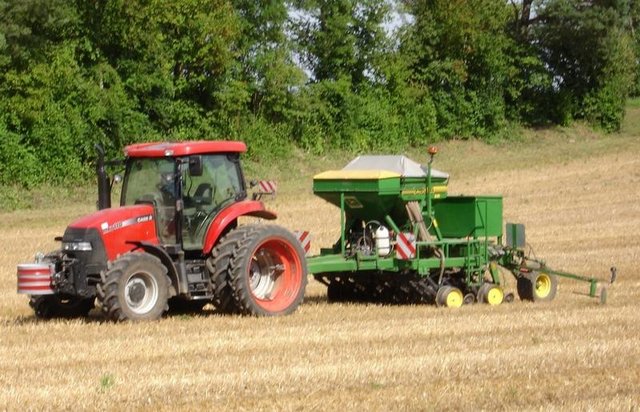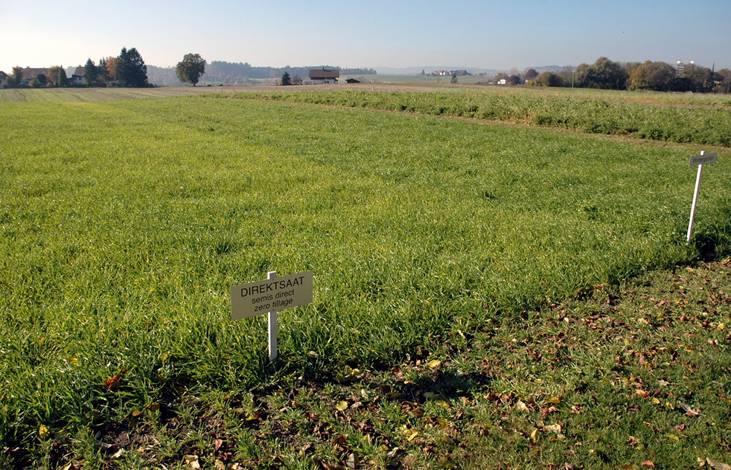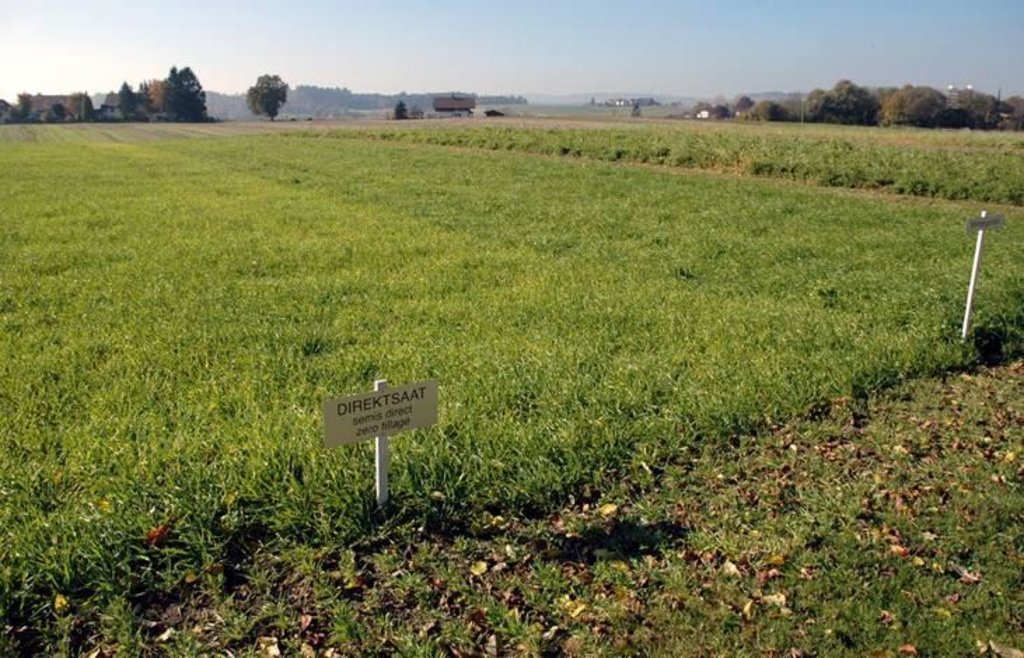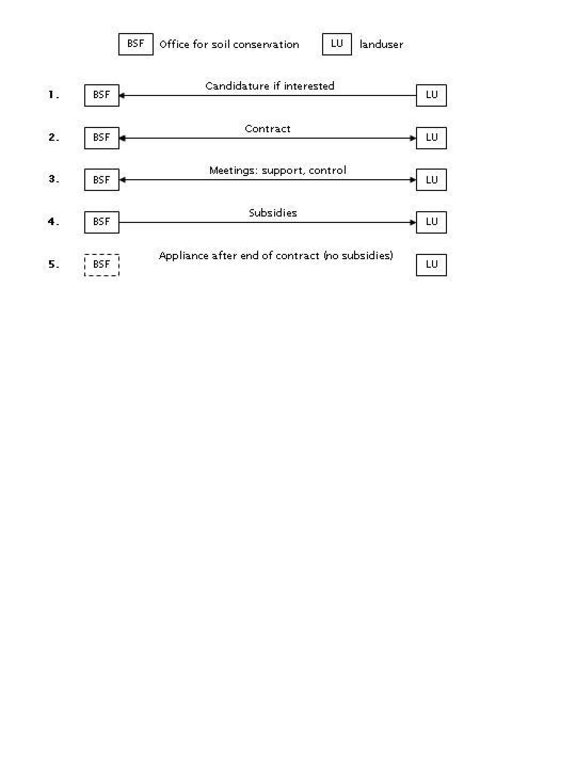Subsidies for conservation agriculture [Suíça]
- Criação:
- Atualização:
- Compilador/a: Unknown User
- Editor: –
- Revisor: David Streiff
Umstellungsverträge
approaches_2632 - Suíça
Veja as seções
Expandir tudo Recolher tudo1. Informação geral
1.2 Detalhes do contato das pessoas capacitadas e instituições envolvidas na avaliação e documentação da abordagem
Pessoa(s) capacitada(s)
Especialista em GST:
Wyler Roman
Suíça
Especialista em GST:
Hofer Peter
+41 (0)31 970 53 37
Peter.hofer@vol.be.ch
Amt für Landwirtschaft und Natur des Kantons Bern LANAT
Rütti, 3052 Zollikofen
Suíça
Nome da(s) instituição(ões) que facilitou(ram) a documentação/avaliação da Abordagem (se relevante)
Amt für Landwirtschaft und Natur des Kantons Bern (LANAT) - Suíça1.3 Condições em relação ao uso da informação documentada através de WOCAT
O/a compilador/a e a(s) pessoa(s) capacitada(s) aceitam as condições relativas ao uso de dados documentados através da WOCAT:
Sim
1.4 Referência ao(s) questionário(s) sobre tecnologias da GST

Direct seeding [Suíça]
A cropping system which allows to plant the seeds directly into the soil without ploughing. The soil is covered with plant remainders.
- Compilador/a: Unknown User
2. Descrição da abordagem de GST
2.1 Descrição curta da abordagem
Land users commit to apply conservation agriculture on parts of their land for a period of 5 years. In return they get subsidies during this period.
2.2 Descrição detalhada da abordagem
Descrição detalhada da abordagem:
Aims / objectives: The Swiss environment protection law defines that soil fertility must be conserved on a long term basis. The cantons have to execute this national law. The way this is done differs from canton to canton. In this study the strategy of the canton of Berne is documented. It has three major goals: The prevention of soil erosion, the reduction of nitrate wash out and the prevention of soil compaction.
Methods: To reach these goals, farmers who accept to use conservation technologies can get additional subsidies for a period of 5 years. Furthermore they are supported by advisors. In this way land users are encouraged to change to soil conservation technologies, financial risk during the establishment phase is reduced due to the subsidies. The approach consist basically of a contract between land users and the office for soil conservation, in which land users commit to apply only soil conservation technologies on parts or on all their land during a period of 5 years. During that time direct seeding must be applied at least 2 times for main crops and for half of the catch crops. For the remaining crops ploughing is not allowed either. Technologies which reduce the reworking of the soil such as maize strip tillage ('Streifenfrässaat') or mulching need to be applied. In return land users get subsidies (during 5 years) which depend on the crop and the technology used. The highest subsidies are granted if direct seeding is used. The office for soil conservation is running a demonstration study comparing direct seeding to conventional agriculture. This helps land users to estimate the effects the new technology would have when applied in practice. If a specific farm receives the subsidies depends on whether in the running year there is still financial resources for the program. Resources have been limited by the government. Additionally it depends on where the farm is located. Farms that located in regions of major nitrate contamination, enhanced risk of eronsion or soil compaction or in regions with drinking water sources or polluted surface water are incorporated first. Land users can have their whole farm or single fields under contract. However a specific field can not be under contract for more than one period (5 years). As soon as a farmer gets a contract, details about which crop to plant where and when, with which technology are discussed by the farmer and an advisor.
Other important information: The goal is to find the best solution for every land user. Meetings of that kind take place on a regular basis. Besides supporting the farmer, advisors also check if conservation agriculture technologies are really being applied. After the 5 years under contract, it is the land users choice whether they want to continue using conservation technologies or not. Monitoring of the office for soil conservation shows that 85% keep on using conservation technologies. Its seems that the approach has a long term influence and subsidies are needed in the beginning only.
2.3 Fotos da abordagem
2.5 País/região/locais onde a abordagem foi aplicada
País:
Suíça
Região/Estado/Província:
Canton of Berne
Map
×2.6 Datas de início e término da abordagem
Indique o ano de início:
1996
Comentários:
It is possible to get subsidies in the whole canton of Berne. Cropland area in the canton is 539 km2, 2517 ha were under contract in the year 2006.
2.7 Tipo de abordagem
- Baseado em projeto/programa
2.8 Principais metas/objetivos da abordagem
The Approach focused on SLM only
Spreading of conservation agriculture in areas with an enhanced risk for soil erosion and or washing out of nutritients. Good quality support so that farmers will not have lower crop yield due to the technology and therefore continue using conservation agriculture after 5 years without external support.
The SLM Approach addressed the following problems: Water erosion under intense rainfall. Washing out of Nitrate to the ground water. Soil compaction.
2.9 Condição que propiciam ou inibem a implementação de tecnologia/tecnologias aplicada(s) segundo a abordagem
Normas e valores sociais/culturais/religiosos
- Inibitivo
Ploughing is an important part of the tradition of agriculture. People are very critical towards no-tillage technologies, since they don't fit the common understanding of agriculture.
Treatment through the SLM Approach: The people working in the project are farmers themselves. They can give on their practical experience. Furthermore a demonstration study can be visited
Disponibilidade/acesso a recursos e serviços financeiros
- Inibitivo
Most farmers have achinery for conventional agriculture. To change to conservation agriculture major investments need to be done or contractors need to be tasked. Furthermore crop yield can be lowered in the beginning.
Treatment through the SLM Approach: When changing to conservation agriculture farmers are supported financially for a period of 5 years.With this money the risk in case of crop failure ond the costs for a contractor are lowered.farmers can test a new techniquewithout major expenses or risks
Quadro jurídico (posse de terra, direitos de uso da terra e da água)
- Inibitivo
If the owner of the farm changes, the new owner often returns to conventional agriculture.
Treatment through the SLM Approach: No solution inside the project
The existing land ownership, land use rights / water rights hindered a little the approach implementation In Switzerland the number of farms is decreasing. New owners of land sometimes change back to conventional agriculture. It is possible however, that the new owner introduces conservation technologies.
Outro
- Inibitivo
In Switzerland there are subsidies to support farmers in hilly terrain. This encourages farmers plant crops on steeper slopes and therefore enhances the risk of erosion. This is not a constraint for the technology however.
Treatment through the SLM Approach: Conservation agriculture helps to reduce erosion. However the project cannot change the fact, that these subsidies enhance the risk of erosion.
3. Participação e papel das partes interessadas envolvidas
3.1 Partes interessadas envolvidas na abordagem e seus papéis
- Usuários de terra/comunidades locais
Contracts are signed by the office for soil conservation and the head of the farm, who in general is male. The decision about which technology is applied is usually taken at the household level including both women and men.
- Especialistas em GST/ consultor agrícola
- Governo nacional (planejadores, responsáveis pelas decisões)
The national government tasked the cantons with soil conservation. Therefore approaches differ from canton to canton.
3.2 Envolvimento do usuários de terra/comunidades locais nas diferentes fases da abordagem
| Envolvimento do usuários de terra/comunidades locais | Especifique quem estava envolvido e descreva as atividades | |
|---|---|---|
| Iniciação/motivação | Nenhum | The project was introduced through the office for soil conservation |
| Planejamento | Participativo | Landusers who wish to get subsidies have contact the office for soil conservation. It is the land users decision on which of their fields they want apply the technology. |
| Implementação | Apoio externo | Land user get subsidies for a period of 5 years, during which they have to apply soil conservation technologies. To actually use the technology they task a contractor or do the work on their own. |
| Monitoramento/avaliação | Participativo | As there are discussions with the advisor on a regular basis, the implementation of the technology is monitored both by the farmer and the advisor. |
| Research | Nenhum | There is a demonstration study where direct seeding and conventional agriculture is compared. |
3.3 Fluxograma (se disponível)
Descrição:
Interactions between the office for soil conservation and land users during the progression of the project.
Autor:
Roman Wyler
3.4 Decisão sobre a seleção de tecnologia/tecnologias de GST
Especifique quem decidiu sobre a seleção de tecnologia/tecnologias a serem implementadas:
- Principalmente especialistas em GST, após consulta com usuários da terra
Explique:
The decisions were taken by the office for soil conservation. Since these people are working as farmers, too, land users perspective could be included.
Decisions on the method of implementing the SLM Technology were made by mainly by land users supported by SLM specialists. To get the subsidies criteria from the contract need to be accepted. Besides this, land users can decide on their own how land is cultivated.
4. Suporte técnico, reforço das capacidades e gestão do conhecimento
4.1 Reforço das capacidades/ formação
Foi oferecida formação aos usuários da terra/outras partes interessadas?
Não
4.2 Serviço de consultoria
Os usuários de terra têm acesso a um serviço de consultoria?
Sim
Especifique se foi oferecido serviço de consultoria:
- nas áreas dos usuários da terra
Descreva/comentários:
nnual meetings between land user and advisor; Key elements: Technical support, Planning of crop rotation and technologies applied, Monitoring
Advisory service is quite adequate to ensure the continuation of land conservation activities; Following a study of the office for soil conservation most land users continue to use conservation technologies after the end of the contract.
4.3 Fortalecimento da instituição (desenvolvimento organizacional)
As instituições foram fortalecidas ou estabelecidas através da abordagem?
- Sim, pouco
Especifique a que nível (níveis) as instituições foram fortalecidas ou estabelecidas:
- Local
Dê mais detalhes:
The office for soil conservation was involved in Swiss no-till, which is a platform to exchange knowledge.
4.4 Monitoramento e avaliação
Monitoramento e avaliação são partes da abordagem?
Sim
Comentários:
bio-physical aspects were regular monitored by 0 through observations; indicators: advisory meetings
technical aspects were regular monitored by 0 through observations; indicators: advisory meetings
economic / production aspects were None monitored by 0 through measurements; indicators: farmer himself
area treated aspects were None monitored by government through measurements; indicators: only the area under contract is known
no. of land users involved aspects were None monitored by 0 through None; indicators: only the number of land users under contract is known
survey aspects were None monitored by land users through None; indicators: afther the first two years there was an evalution of the project. Farmers were asked for their opini
4.5 Pesquisa
A pesquisa foi parte da abordagem?
Sim
Especifique os tópicos:
- Tecnologia
Dê mais detalhes e indique quem realizou a pesquisa:
Research is not part of the actual project. However the advisors are involved in research projects through other activities. Therefore new knowledge is usually incorporated in the advisory meetings.
Research was carried out both on station and on-farm
5. Financiamento e apoio material externo
5.1 Orçamento anual para o componente de GST da abordagem
Caso o orçamento exato seja desconhecido, indique a faixa:
- 100.000-1.000.000
Comentários (p. ex. principais fontes de recursos/principais doadores):
Approach costs were met by the following donors: government (Kanton Bern): 100.0%
5.2 Apoio financeiro/material concedido aos usuários da terra
Os usuários da terra receberam apoio financeiro/material para a implementação de tecnologia/tecnologias?
Sim
Caso afirmativo, especifique tipo(s) de apoio, condições e fornecedor(es):
Canton of Berne
5.3 Subsídios para entradas específicas (incluindo mão-de-obra)
- Agrícola
| Especifique quais entradas foram subsidiadas | Em que medida | Especifique os subsídios |
|---|---|---|
| Sementes | Parcialmente financiado | |
| Fertilizantes | Parcialmente financiado | |
Comentários:
There are subsidies per field under contract for a period of 5 years. During that time direct seeding must be applied at least 2 times for main crops and for half of the catch crops. For the remaining crops ploughing is not allowed either.
5.4 Crédito
Foi concedido crédito segundo a abordagem para atividades de GST?
Não
6. Análise de impactos e declarações finais
6.1 Impactos da abordagem
A abordagem auxiliou os usuários da terra a implementar e manter as tecnologias de GST?
- Não
- Sim, pouco
- Sim, moderadamente
- Sim, significativamente
the advisory meetings help land users to better understand soil processes.
A abordagem concedeu autonomia aos grupos social e economicamente desfavorecidos?
- Não
- Sim, pouco
- Sim, moderadamente
- Sim, significativamente
Did other land users / projects adopt the Approach?
- Não
- Sim, pouco
- Sim, moderadamente
- Sim, significativamente
Other cantons in Switzerland have started to subsidise conservation agriculture too.
Did the Approach lead to improved livelihoods / human well-being?
- Não
- Sim, pouco
- Sim, moderadamente
- Sim, significativamente
income is slightly enhanced in most cases.
Did the Approach help to alleviate poverty?
- Não
- Sim, pouco
- Sim, moderadamente
- Sim, significativamente
6.2 Principal motivação dos usuários da terra para implementar a GST
- Lucro (lucrabilidade) aumentado, melhora da relação custo-benefício
- Pagamentos/subsídios
- Consciência ambiental
prevention of erosion
6.3 Atividades de sustentabilidade de abordagem
Os usuários da terra podem manter o que foi implementado através da abordagem (sem apoio externo)?
- Sim
Caso afirmativo, descreva como:
on a long term perspective conservation agriculture is rather cheaper. Only in the beginning it costs more.
6.4 Pontos fortes/vantagens da abordagem
| Pontos fortes/vantagens/oportunidades na visão do usuário da terra |
|---|
| Not land user, but advisor of the project! |
| The structure of the project enables individual solutions. Still there are incentives for conservation agriculture. (How to sustain/ enhance this strength: Working together with the land users, searching for the best individual solution.) |
| After the end of the contract, there are no costs anymore. (How to sustain/ enhance this strength: armers should be supported as good as possible, so that they are familiar with the technology and continue to apply it after the end of the contract.) |
| Advisors involved in the project all have an agricultural background, they are therefore familiar with the problems of farmers. (How to sustain/ enhance this strength: Working together with the farmers and trying adjust the program to their needs.) |
6.5 Pontos fracos, desvantagens da tecnologia e formas de superá-los
| Pontos fracos/desvantagens/riscos na visão do usuário da terra | Como eles podem ser superados? |
|---|---|
| Compared to the total number of farms the number of participants is rather small. | conditions for participation could be reduced in order to reach more people. This would however increase the costs. |
| Pontos fracos/vantagens/riscos na visão do/a compilador/a ou de outra pessoa capacitada | Como eles podem ser superados? |
|---|---|
| Subsidies are expensive for the state. Since resources are limited there is already a waiting list for the farmers. | soil consvervation should get a higher importance in politics. This is not the case because most people don't even know that soil degradation is a problem. |
| f there is no possibility to rent the machines in the region, costs are very high, even if there are subsidies. | here it could be a possiblity to support contractors to buy the machines needed, so that land users could apply the technology at lower costs. |
7. Referências e links
7.1 Métodos/fontes de informação
- visitas de campo, pesquisas de campo
- entrevistas com especialistas em GST
7.2 Referências às publicações disponíveis
Título, autor, ano, ISBN:
Amt für Landwirtschaft und Natur des Kantons Bern LANAT, Rütti, 3052 Zollikofen. Kanton Bern fördert Ressourcen schonenden Ackerbau.AGRARForschung 14 (3): 128-133, 2007.
Disponível de onde? Custos?
http://www.vol.be.ch/site/lanat-3155-mbressourcen.pdf
Links e módulos
Expandir tudo Recolher tudoLinks

Direct seeding [Suíça]
A cropping system which allows to plant the seeds directly into the soil without ploughing. The soil is covered with plant remainders.
- Compilador/a: Unknown User
Módulos
Não há módulos






